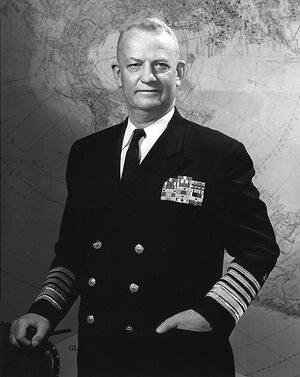Arleigh Burke
( mariner) | |
|---|---|
 | |
| Born | 1901-10-19 Boulder, Colorado, U.S. |
| Died | 1996-01-01 (Age 94) Bethesda, Maryland, U.S. |
| Nationality | US |
| Founder of | Center for Strategic and International Studies |
| Member of | Center for Strategic and International Studies |
US admiral, one of the founders of Center for Strategic and International Studies | |
Arleigh Albert Burke was an admiral of the United States Navy who distinguished himself during World War II and the Korean War, and who was Chief of Naval Operations during the Eisenhower and Kennedy administrations. He was co-founder of the spooky Center for Strategic and International Studies.
Korean War
At the outbreak of the Korean War, Admiral Forrest Sherman, then Chief of Naval Operations, ordered Burke to duty as Deputy Chief of Staff to Commander Naval Forces Far East. From there, he assumed command of Cruiser Division Five, and, in July 1951, was made a member of the United Nations Truce Delegation which negotiated with the Communists for military armistice in Korea. After six months in the truce tents, he returned to the Office of Chief of Naval Operations where he was Director of Strategic Plans Division until 1954.[1]
In April 1954, he took command of Cruiser Division Six, then moved in January 1955 to command Destroyer Force Atlantic Fleet (DesLant). In August 1955, Burke succeeded Admiral Robert B. Carney as Chief of Naval Operations. At the time of his appointment as Chief of Naval Operations, Burke was still a rear admiral, upper half (two star) and was promoted over the heads of many Flag Officers who were senior to him. Burke had never was a vice admiral (three star), so he was promoted two grades at the time of his appointment.[2]
Burke took the post of Chief of Naval Operations in 1955 with significant reservations. He served at a critical time in world history, during the depths of the Cold War. He was relatively young compared to other Flag Officers at the time. He was a hard worker, and seemingly tireless, working fifteen-hour work days six days a week as a norm. He was also an excellent leader and manager, and his ability to create an effective organization were keys to his success. He supported the notoriously demanding Admiral Hyman Rickover in the development of a nuclear-powered submarine force, and instituted the development of submarine-launched ballistic missiles, which led to the Polaris missile program, headed by Burke's selectee Rear Admiral W. F. "Red" Raborn.[3] Burke convened the Project Nobska anti-submarine warfare conference in 1956 at the suggestion of Columbus Iselin II, director of the Woods Hole Oceanographic Institution, where discussion ranged from oceanography to nuclear weapons. At the conference, a statement by Edward Teller that a physically small one-megaton warhead suitable for Polaris could be developed led to Burke's adoption of Polaris over Jupiter.[4] At a time when others in the Navy were very skeptical of the idea of a missile launched from a submarine, Burke succeeded in developing the single most effective deterrent to a nuclear attack on the United States. By 1961 routine Polaris deterrent patrols were in progress and a rapid construction program of Polaris submarines was underway.
Burke as Chief of Naval Operations was intimately involved in the Eisenhower administration discussions on limiting the size of the submarine force. Asked "how much is enough?", as to the number of US ballistic missile submarines needed for deterrence, Burke argued that a force of around 40 Polaris submarines (each with 16 missiles) was a reasonable answer.[5] Burke further argued that land-based missiles and bombers were vulnerable to attack, which made the U.S.-Soviet nuclear balance dangerously unstable. By contrast, nuclear submarines were virtually undetectable and invulnerable. He was very critical of "hair trigger" or "launch on warning" nuclear strategies, and he warned that such strategies were "dangerous for any nation." [6]
Burke served an unprecedented three terms as Chief of Naval Operations during a period of growth and progress in the Navy. Upon completing his third term, he was transferred to the Retired List on August 1, 1961.[7]
References
- ↑ https://www.nytimes.com/1996/01/02/us/arleigh-a-burke-dies-at-94-naval-hero-of-world-war-ii.html?pagewanted=all
- ↑ https://www.nytimes.com/1996/01/02/us/arleigh-a-burke-dies-at-94-naval-hero-of-world-war-ii.html?pagewanted=all
- ↑ Friedman, Norman (1994). U.S. Submarines Since 1945: An Illustrated Design History. Annapolis, Maryland: United States Naval Institute. pp. 193–194.
- ↑ Friedman, Norman (1994). U.S. Submarines Since 1945: An Illustrated Design History. Annapolis, Maryland: United States Naval Institute. pp. 109–114
- ↑ http://www.gwu.edu/~nsarchiv/nukevault/ebb275/index.htm "How Much is Enough?": The U.S. Navy and "Finite Deterrence", National Security Archive Electronic Briefing Book No. 275
- ↑ http://www.gwu.edu/~nsarchiv/nukevault/ebb275/index.htm#doc11 "Document 11: "Dangerous For Any Nation", in National Security Archive Electronic Briefing Book No. 275
- ↑ https://www.nytimes.com/1996/01/02/us/arleigh-a-burke-dies-at-94-naval-hero-of-world-war-ii.html?pagewanted=all